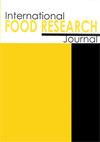Effect of peeling, filling medium, and storage on the antioxidant activity and phenolic compounds of canned figs (Ficus carica L.)
IF 1
4区 农林科学
Q4 FOOD SCIENCE & TECHNOLOGY
引用次数: 0
Abstract
The fig fruit, which has a short seasonal availability due to its perishable nature, was subjected to a canning process, and the effects of canning on phenolics and antioxidant properties were evaluated. For this purpose, the most popular fig varieties grown in Türkiye, namely Sarilop (yellow coloured) and Bursa Siyahi (dark purple coloured), were canned in different filling mediums such as syrup, water, and fig juice, as peeled or unpeeled. The canned figs were also stored at room temperature for 12 months, and the changes in phenolics and antioxidant properties during storage were determined. The canning process preserved a great part of the phenolics and antioxidant capacity. After canning, the Sarilop figs experienced a minor reduction in their total phenolic content, whereas no significant change was observed in the total phenolic content of the Bursa Siyahi figs. The total antioxidant activity of the figs increased by canning, which was observed more clearly for the unpeeled Bursa Siyahi figs. At the end of the storage, both Sarilop and Bursa Siyahi figs canned with fig juice had higher total phenolics, total antioxidant activity, and individual phenolics than the figs canned with other filling mediums. During the 12-month storage period, the most stable phenolic compounds found in the canned figs were rutin and gallic acid. However, the monomeric anthocyanins of the Bursa Siyahi figs were negatively affected by the storage and canning process.去皮、灌装介质和储存对无花果罐头抗氧化活性和酚类化合物的影响
无花果果实因其易腐烂而季节性较短,我们对其进行了罐装处理,并评估了罐装对酚类物质和抗氧化特性的影响。为此,将土尔其种植的最受欢迎的无花果品种,即 Sarilop(黄色)和 Bursa Siyahi(深紫色),分别去皮或不去皮,用糖浆、水和无花果汁等不同的灌装介质制成罐头。无花果罐头还在室温下储存了 12 个月,并测定了储存过程中酚类物质和抗氧化特性的变化。罐装过程保留了大部分酚类物质和抗氧化能力。装罐后,萨里洛普无花果的总酚含量略有下降,而布尔萨西亚希无花果的总酚含量没有明显变化。无花果的总抗氧化活性在罐装后有所增加,这一点在未去皮的布尔萨西雅希无花果中表现得更为明显。贮藏结束时,用无花果汁罐装的萨里洛普无花果和布尔萨西雅希无花果的总酚类物质、总抗氧化活性和单个酚类物质均高于用其他填充介质罐装的无花果。在 12 个月的储存期间,无花果罐头中最稳定的酚类化合物是芦丁和没食子酸。不过,布尔萨西雅希无花果的单体花青素受到储存和罐装过程的负面影响。
本文章由计算机程序翻译,如有差异,请以英文原文为准。
求助全文
约1分钟内获得全文
求助全文
来源期刊

international food research journal
Agricultural and Biological Sciences-Food Science
CiteScore
1.40
自引率
0.00%
发文量
75
期刊介绍:
The International Food Research Journal (IFRJ) publishes papers in English, six (6) issues a year with the coverage of:
Food Science and Technology
Nutrition and Dietetics
Agriculture, multidisciplinary
Chemistry, multidisciplinary
The scope of the Journal includes:
Food Science, Food Technology and Food Biotechnology
Product Development and Sensory Evaluation
Food Habits, Nutrition, and Health
Food Safety and Quality
Food Chemistry, Food Microbiology, Food Analysis and Testing
Food Engineering
Food Packaging
Food Waste Management
Food Entrepreneur
Food Regulatory
Post-Harvest Food Management
Food Supply Chain Management
Halal Food and Management
 求助内容:
求助内容: 应助结果提醒方式:
应助结果提醒方式:


